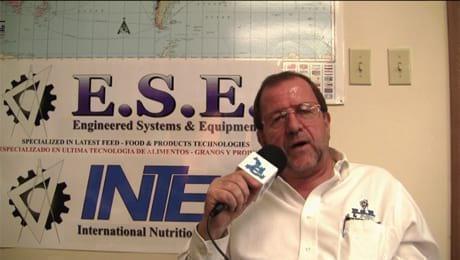Explore all the information on
Feed additives
Welcome to the page about Feed additives of Engormix; a source of knowledge on Feed additives.
Introduction Animals used for food production have been genetically selected for feed intake and muscle development (or milk and egg production) and are therefore divergent from their ancestors. In addition, these animals are reared in conditions that favor fast spread of pathogens. The high uptake of feed and the fast growth make these animals prone to intestinal disorders, what has been neglected in the past because of the use of low doses of...
Comments : 0
Recommendations: 1
1. Introduction In commercial dairy and beef production, a range of stresses are responsible for economic losses associated with the decreased productive and reproductive performance of cows. It has been shown that at the molecular level, nutritional, technological, environmental and internal stresses lead to the overproduction of free radicals, the disturbance of the redox balance, and oxidative stress [1,2]. It is well known that oxidative stress (an imbalance between free...
Comments : 0
Recommendations: 1


Rebuilding & Remanufacturing of used equipment. J. Barbi (E.S.E. & Intec)
Suggested link
Animal feed organic trace minerals play a crucial role in a variety of cattle functions, including digestion, immunity, reproduction, and overall growth. Lack of nutrition in animal feed and concerns related to cattle health are driving the demand for sustainable animal feed. Organic trace minerals for cattle are considered superior to inorganic trace minerals as they provide enhanced gut absorption and bioavailability.
As per the United Nations Food and Agriculture Organization...
Comments : 0
Recommendations: 0
...
Comments : 0
Recommendations: 2
.jpg&w=3840&q=75)

Blending technology and sustainable solutions
Suggested link
1. Introduction Monogastric animal production, in particular the poultry production sector, is growing continuously, driven mostly by the demand for meat and eggs. However, this rapidly growing industry and the increasing demand for poultry feeds have led to a considerable increase in feedstuff prices. The gap between demand and supply of balanced feed is expected to increase, and consequently increase the cost of production....
Comments : 1
Recommendations: 0
This virtual seminar will take place via Zoom meetings in four days (20, 27, 29, and 30th of September, 2021), from 16:00 to 18:30 (Spain time). All the conferences will be given in English and there will be simultaneous translation to Spanish. The seminar will...
Comments : 0
Recommendations: 1


Rebuilding & Remanufacturing of used equipment. J. Barbi (E.S.E. & Intec)
Suggested link
Introduction Pressed sugar beet pulp (PSBP) is frequently ensiled in plastic bags and represent a valuable feed component of feed rations for ruminants. However, its high susceptibility to fungal infestation during feed-out, especially in summer, often results in low stability and poor hygienic quality (Kalzendorf, 2007). Therefore, especially the use of chemical additives containing salts of sorbic, benzoic and and/or propionic acids, has attracted significant attention...
Comments : 1
Recommendations: 0
The burgeoning demand for animal nutritional products is a key factor anticipated to accelerate Europe inactive dry yeast market for animal feed application over the ensuing years. In recent years, inactive dried yeast products have gained significant prominence for animal feed applications as they are a pivotal source of protein with both non-essential and essential amino acid profiles, which is vital for the healthy growth of poultry animals. Besides, an increase in livestock production...
Comments : 0
Recommendations: 0
.jpg&w=3840&q=75)

Blending technology and sustainable solutions
Suggested link
The demand for fish protein hydrolysate products across the animal feed and pet food applications will attain traction on account of the increasing requirement for new functional foods. There is a significant influx of advanced throughput technologies that exhibit low environmental impact and superior economic sustainability.
Fish protein hydrolysates have excellent nutritive value as well as amino content and are consumed as either stand-alone items or components of functional...
Comments : 0
Recommendations: 2
Introduction Silver has been known for antibacterial activity since ancient times. The importance of silver has regained due to the increase of bacterial resistance to antibiotics, caused by their overuse. Silver nano particles and silver based compounds containing ionic silver (Ag + ) or metallic silver (Ag 0 ) which possess antimicrobial activity are of great importance in the field of medicine. Silver nano particles are attractive as these are non -toxic to...
Comments : 0
Recommendations: 0


Rebuilding & Remanufacturing of used equipment. J. Barbi (E.S.E. & Intec)
Suggested link
1. Introduction Phytogenic feed additives (PFA) are the plant derived products used to improve performance of livestock and poultry (Windisch et al., 2008; Jacela et al., 2010). The PFA comprise of a wide variety of herbs, spices and products derived thereof and are mainly essential oils. This class of feed additives is at present used to a great extent as alternatives to the antibiotic growth promoters (AGP) in poultry and swine nutrition. Obviously, the ban imposed on the...
Comments : 0
Recommendations: 3
INTRODUCTION Among the essential amino acids (AA), L-arginine (ARG) is one of the functional amino acids in animals. ARG is a nutritionally very important and essential AA for fish, and is considered the fourth limiting AA in aquafeed. Most of fish species excretes ammonia predominantly through the gills, diffusing NH 3 or NH 4 (ammoniotelic animals). Therefore, unlike mammals, fish have a low hepatic activity of carbamoyl phosphate synthase III or ornithine carbamoyl...
Comments : 0
Recommendations: 1
.jpg&w=3840&q=75)

Blending technology and sustainable solutions
Suggested link
by Sam Shafer
As demand for goose products increases, poultry scientists and producers are working to combat bird mortality. One goal is to help geese fight infections without overusing antibiotics.
In a new study, published The Journal of Applied Poultry Research, poultry scientists explore the use of dietary yeast culture (YC) supplementation as a strategy to boost goose health while also improving meat quality.
Yeast culture is a dried prebiotic...
Comments : 0
Recommendations: 0
Introduction Silver has long been known to exhibit a strong toxic activity towards a wide range of microorganisms, for this reason silver based compounds have been extensively used in many bactericidal applications. Nano particles due to their large surface area are highly reactive and Ag Nano particles have been tested in various fields of biological sciences, Viz drug delivery, wound treatment, binding with HIV gp120 protein , in water treatment and as antibacterial compound...
Comments : 0
Recommendations: 0


Rebuilding & Remanufacturing of used equipment. J. Barbi (E.S.E. & Intec)
Suggested link
Due to the projections of accelerated growth of world population, it is essential to increase the production of proteins from animal and plant origin. Insects have been used as an alternative protein source for humans (entomophagy) and other animals because of their greater efficiency in food conversion and less environmental impact (Van Huis et al. 2013, Van Huis 2013, Van Huis 2020). Edible insect larvae contain an average of 54% protein, including essential amino acids and vitamin...
Comments : 0
Recommendations: 0
The increasing price of corn and soybean meal raises questions about using alternative raw material in a way that would not affect animal performance. In this Tech Talk, Novus's Ermin and Annafe discuss how CIBENZA® DP100 can help increase the flexibility of raw materials usage, optimize savings on feed costs, and still maintain animal performance....
Comments : 0
Recommendations: 1
.jpg&w=3840&q=75)

Blending technology and sustainable solutions
Suggested link
Novus is launching Tech Talks, a video series to address our customers' pain points and industry challenges. The prices of corn and soybean meal continue to rise due to supply shortages. In our first Tech Talk, hear what Sr. Product Specialist Annafe Perino and Sr. Technical Services Specialist Ermin Magtagnob have to share on the issue of high raw material price and how protease enzymes can help....
Comments : 0
Recommendations: 4
The North America specialty animal feed additives market is projected to accrue sizable revenue growth on account of rapid expansion activities in the eggs and meat industry. Animal feed additives are preparations or substances that are added for enhancing feed quality and boosting animal nutrition.
Major regulatory organizations like the U.S. FDA are classifying animal feed additives under the Generally Recognized as Safe (GRAS) category. This makes them safe for human and animal...
Comments : 0
Recommendations: 0


Rebuilding & Remanufacturing of used equipment. J. Barbi (E.S.E. & Intec)
Suggested link
Summary: - A growing population that we have to feed by 2050, approximately 9,000 million inhabitants. - Climate change, global warming, atmospheric phenomena (Hurricanes, floods, prolonged drought that drastically affects grain crops). - Overfishing in our seas that are decimating and extinguishing some marine species. ...
Comments : 0
Recommendations: 1
...
Comments : 1
Recommendations: 0


















